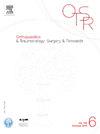机会性 CT 筛查显示骨质疏松患者发生关节周围骨折的风险增加。
IF 2.3
3区 医学
Q2 ORTHOPEDICS
引用次数: 0
摘要
背景:骨质疏松症诊断不足或治疗不力不仅会影响个人的发病率和死亡率,还会影响整个医疗系统和社区。双能 X 射线吸收测量法(DXA)是确定骨质疏松症的金标准方法,然而,机会性 CT 筛查能够在腹部骨盆成像中精确估算骨矿密度(BMD),而且不会增加成本、辐射暴露或给患者带来不便。本研究利用机会性 CT 筛查来确定本院下肢骨折患者的骨质疏松症患病率和解剖分布模式:假设:骨质密度(BMD)低的创伤患者更有可能出现关节周围骨折而非轴突骨折:我们对一级创伤中心急诊科(ED)收治的 721 名下肢骨折的创伤患者进行了回顾性分析。未满18岁或到达急诊室时未进行CT扫描的患者被排除在外。在 CT 扫描的 L1 椎骨水平测量 Hounsfield 单位 (HU),以确定骨矿密度。测量值≤100 HU为骨质疏松症,101-150 HU为骨质疏松症:结果:最终结果包括 416 名患者,平均年龄为 49 ± 21 岁。平均骨密度为 203.9 ± 73.4 HU。15.9%的患者被诊断为骨质疏松,9.9%的患者被诊断为骨质疏松。64.2%的骨折为关节周围骨折,25.7%为骨干骨折,10.1%为混合骨折。关节周围骨折的平均 BMD 明显低于骨干骨折(189 ± 74.7 HU vs. 230.6 ± 66.1 HU,P 讨论):我们的研究表明,低骨矿物质密度与下肢骨折模式之间存在显著关系,但这可能受到性别等其他因素的影响。在创伤环境中对骨质疏松症进行机会性 CT 筛查为早期发现低骨矿物质密度和实施高效的生活方式调整和药物治疗干预提供了充分的机会。随着CT筛查的广泛应用,关节周围骨折的总发病率将会降低,从而减少目前困扰患者、医疗系统和社区的发病率、死亡率和总成本:证据等级:III,治疗。本文章由计算机程序翻译,如有差异,请以英文原文为准。
Opportunistic CT screening demonstrates increased risk for peri-articular fractures in osteoporotic patients
Background
Underdiagnosis or undertreatment of osteoporosis consequently impacts individual morbidity and mortality, as well as on healthcare systems and communities as a whole. Dual-energy x-ray absorptiometry (DXA) is the gold standard method for identifying osteoporosis, however, opportunistic CT screening is capable of precisely estimating bone mineral density (BMD) in abdominopelvic imaging with no additional cost, radiation exposure or inconvenience to patients. This study uses opportunistic CT screening to determine the prevalence of osteoporosis and anatomic distribution patterns in patients presenting with lower extremity fractures at our institution.
Hypothesis
Trauma patients with low bone mineral density (BMD) are more likely to present with peri-articular versus shaft fractures.
Patients and methods
We conducted a retrospective review of 721 patients presenting as trauma activations to the emergency department (ED) of a Level 1 Trauma Center with lower extremity fractures. Patients were excluded if under the age of 18 or lacking a CT scan upon arrival in the ED. Hounsfield Units (HU) were measured at the L1 vertebral level on CT scans to determine bone mineral density. Values of ≤100 HU were consistent with osteoporosis, whereas 101–150 HU were consistent with osteopenia.
Results
The final cohort included 416 patients, with mean age of 49 ± 21 years. Average bone density was 203.9 ± 73.4 HU. 15.9% of patients were diagnosed as osteopenic and 9.9% as osteoporotic. 64.2% of fractures were peri-articular, 25.7% were shaft, and 10.1% were a combination. Peri-articular fractures were significantly more likely to have lower average BMD than shaft fractures (189 ± 74.7 HU vs. 230.6 ± 66.1 HU, p < 0.001).
Discussion
Our study demonstrates a significant relationship between low bone mineral density and lower extremity fracture pattern, however, likely influenced by other factors such as sex. Opportunistic CT screening for osteoporosis in trauma settings provides ample opportunity for early detection of low BMD and implementation of highly effective lifestyle modification and pharmacotherapy intervention. Reduction in the overall incidence of peri-articular fracture with widespread adoption of opportunistic CT screening may lessen the morbidity, mortality, and total cost currently afflicting patients, healthcare systems, and communities.
Level of evidence
III, therapeutic
求助全文
通过发布文献求助,成功后即可免费获取论文全文。
去求助
来源期刊
CiteScore
5.10
自引率
26.10%
发文量
329
审稿时长
12.5 weeks
期刊介绍:
Orthopaedics & Traumatology: Surgery & Research (OTSR) publishes original scientific work in English related to all domains of orthopaedics. Original articles, Reviews, Technical notes and Concise follow-up of a former OTSR study are published in English in electronic form only and indexed in the main international databases.

 求助内容:
求助内容: 应助结果提醒方式:
应助结果提醒方式:


